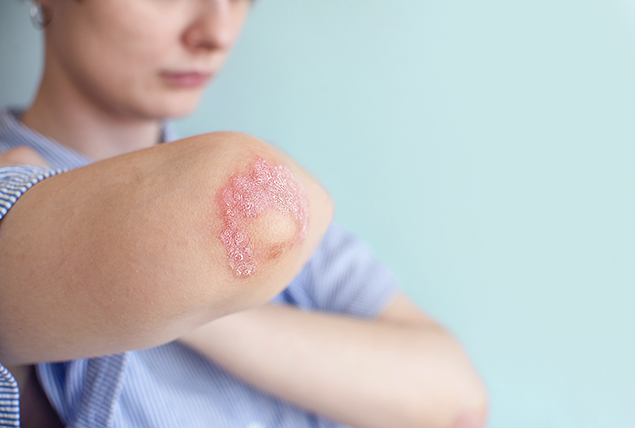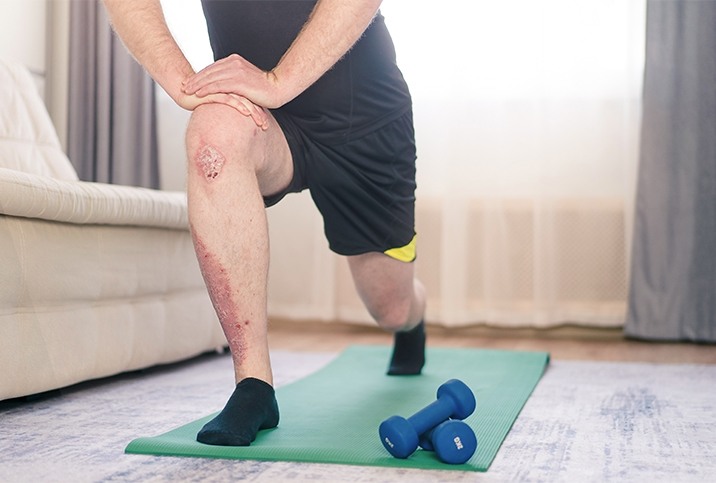Do You Know What Causes Psoriasis and Triggers Flare-ups?

It's a disease millions of people around the globe deal with every day, yet researchers are still hunting for a cure. Psoriasis—a chronic, inflammatory condition that impacts the skin, joints and some organs—affects more than 8 million Americans, according to the National Psoriasis Foundation, and it's estimated that 2 percent to 3 percent of the world's population has the disease.
Psoriasis plaque types are varied and can look different from other types of plaque and appear in various locations on the body.
Psoriasis can affect people of all identities, and there are certain times when people usually experience their first bout, according to Vladyslava Doktor, D.O., a dermatologist and the owner of Skin Center Boston.
"Psoriasis can appear at any age from infancy to the eighth decade. About 75 percent of people with psoriasis develop it before the age of 40," Doktor said. "Typically, there are two peaks for the age of onset: one at 20 to 30 years of age and a second peak at 50 to 60 years. It affects both males and females equally and occurs across all racial and ethnic groups."
So what exactly is it like to experience initial onset or a flare-up of psoriasis? What are the forms the common condition can take? What are the risk factors that may contribute to developing psoriasis? What are the circumstances and causes that can create recurrent flare-ups?
What is psoriasis?
Psoriasis commonly appears on your scalp, elbows, knees, fingernails, hands and torso, but there's more to psoriasis than what meets the eye. It can be a chronic, lifelong condition for many people.
"Psoriasis is an autoimmune disease, which, put simply, means your body is attacking itself by mistake," said Fred Pescatore, M.D., a New York City-based family medicine physician and author specializing in nutrition. "In the case of psoriasis, immune cells attack the skin. Inflammation is your body's natural response to this attack."
Your body thinks the skin needs repair as a result of the attack, so it creates new skin cells. Since the skin cells aren't needed, an excess develops. The new skin cells push the old ones to the surface, and those present as psoriasis symptoms.
Psoriasis can take on a variety of physical forms, and the disease can be accompanied by other health conditions, both physical and mental.
"Psoriasis can look reddish or even violaceous and gray on more richly pigmented skin and often has a silvery type of scaling," said Geeta Yadav, M.D., a Toronto-based dermatologist at FACET Dermatology. "People with psoriasis may also have psoriatic arthritis, which affects the joints, causing inflammation and pain.
"Something that's not often discussed is the mental toll that this condition can take. Depending on the severity of the scales, how widespread they are and where they are, psoriasis can lead to depression and anxiety about one's appearance."
What forms does psoriasis take?
Your psoriasis will undergo flare-ups that last a few weeks or months, followed by periods of remission. Typically, Doktor said, flares begin with the appearance of red patches on your skin and progress to thickened plaques covered by silvery scales. Though not all forms of psoriasis share this classic presentation, most people with psoriasis report a few common symptoms.
"Each type of psoriasis has its own unique appearance and location on the body, and treatment options can vary depending on the type and severity of the condition," Doktor said. "In addition to its visual symptoms, psoriasis is also known to be extremely itchy and can be accompanied by pain, burning or stinging sensations."
Doktor and Yadav outlined the handful of forms psoriasis can take.
Plaque psoriasis
"The most common type of psoriasis appears as raised, red patches covered with silvery scales. These patches can occur anywhere on the body, but they most commonly appear on the scalp, knees, elbows, lower back and genitals," Doktor said.
During flare-ups, plaque psoriasis can be more flaky, itchy and painful, according to Yadav.
"As it resolves, it can leave areas of hyper- and hypopigmentation," she added. "Usually, this resolves, but the speed of improvement depends on your background skin color, as well as the skin site that is affected."
Guttate psoriasis
This form appears as small, pink, droplet-shaped lesions on the skin, and often occurs in children and young adults, according to Doktor. It is usually triggered by a bacterial infection. Strep throat is one such infection.
Inverse psoriasis
Doktor said this form of psoriasis appears in the folds of the skin, such as the armpits, groin and under the breasts. Its smooth, shiny, red lesions are aggravated by sweat and friction.
Nail psoriasis
When psoriasis affects your fingernails, they can become discolored, pitted and thickened, Doktor said.
"It can also cause the nails to detach from the nail bed," she added.
Scalp psoriasis
"This appears as red, itchy, scaly patches on the scalp, and it can extend beyond the hairline onto the forehead, neck and ears, making it more noticeable," Doktor said.
Pustular psoriasis
This rare type of psoriasis appears as pus-filled blisters on the skin. It can occur anywhere on the body, but its most common locations are the hands and feet.
"This type of psoriasis can be cyclical, and while the pus does not contain an infection, it can cause flu-like symptoms, including chills, a fast heartbeat, fever, weakness in muscles and appetite loss," Doktor said.
Such symptoms should initiate a visit to an emergency room or urgent walk-in care, Yadav said.
Erythrodermic psoriasis
This is a rare and severe form of psoriasis that can affect your whole body. It appears as a red, peeling rash that can cause intense itching and burning.
"This is a very serious condition that might require hospitalization to control your body's temperature," Doktor said. "It can evolve from other types of psoriasis or even from a sunburn."
What risk factors contribute to developing psoriasis?
Psoriasis is a complex disease that can be caused by a combination of genetic, behavioral and environmental factors. Common risk factors that contribute to psoriasis include:
- A family history of psoriasis
- Stress
- Trauma
- Medications
- Infections (such as strep throat)
- Smoking
- Obesity
- Increased alcohol consumption
What triggers a flare-up of psoriasis?
Many people with psoriasis enjoy long periods during which their symptoms remain in remission. In moments of increased stress or even during winter months when your skin loses moisture, you may experience a recurrent flare-up of your psoriasis symptoms.
Common factors that can contribute to flare-ups of psoriasis include:
- Stress
- Infections
- Injury to the skin
- Hormonal changes
- Smoking
Dietary factors are another contributing factor. Johns Hopkins Medicine reported that foods containing dairy, refined carbohydrates, saturated fats, trans fats, added sugars and gluten may contribute to inflammation and a flare-up of psoriasis symptoms.
Can drinking cause psoriasis? Not the condition itself, as it is an autoimmune disorder. But according to Johns Hopkins Medicine, alcohol can contribute to flare-ups. With time, heavy drinking leads to inflammation of the liver, colon and intestines and a worsening of psoriasis symptoms.
Dry air and lower temperatures may cause psoriasis to flare up, according to Pescatore. So even the weather isn't on your side.
"Dry air can cause the skin to lose moisture, especially in the upper layers, which results in dry, flaky skin," he said. "Studies have also found that fewer hours of sunlight in the winter may trigger psoriasis flare-ups."
The bottom line
Psoriasis is one of more than 100 autoimmune conditions and one of the most common. It often appears on the scalp, elbows, knees, fingernails, hands and torso, and for many people, it can be a chronic, lifelong condition.
A follow-up story will highlight how the condition is diagnosed and treated.


















